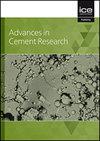Early hydration studies of cementitious materials incorporating nanoalumina
IF 1.3
4区 工程技术
Q3 CONSTRUCTION & BUILDING TECHNOLOGY
引用次数: 0
Abstract
Concrete technologists use different types of additives such as fly ash, slag, natural pozzolans and nanomaterials toenhance concrete performance and durability. However, a detailed explanation of the early-age hydration process and microstructural modification of concrete in the presence of nanomaterials remains to be presented and extensive research is required for strategic modification of cementitious systems. This study focused on the precise monitoring of early-age hydration with the incorporation of nanoalumina (nAl) in tricalcium silicate (C3S) and Portland cement paste and mortar. The dosage of nAl was varied from 1 to 5% (by weight) in C3S and from 0.1 to 1.0% in Portland cement, with a water/cement ratio of 0.4. The hydration studies showed that the nAl increased the cross-linkage in calcium silicate hydrate gel through substitution of aluminium by silicon, which was responsible for the enhancement of the modulus of elasticity (by 40%) with 1.0% nAl) after 7 days of hydration. In summary, the incorporation of nAl modified the concrete microstructure in the initial days of hydration, leading to higher concrete performance and longer service lives of concrete structures.含纳米氧化铝胶凝材料的早期水化研究
混凝土技术人员使用不同类型的添加剂,如粉煤灰、矿渣、天然火山灰和纳米材料来提高混凝土的性能和耐久性。然而,在纳米材料的存在下,混凝土的早期水化过程和微观结构改性的详细解释仍然有待提出,并且需要对胶凝体系的战略性改性进行广泛的研究。本研究的重点是精确监测纳米氧化铝(nAl)掺入硅酸三钙(C3S)和硅酸盐水泥膏体和砂浆的早期水化。在C3S中,nAl的用量为1 ~ 5%(重量比),在波特兰水泥中,nAl的用量为0.1 ~ 1.0%,水灰比为0.4。水化研究表明,nAl通过硅取代铝增加了水化硅酸钙凝胶中的交联,这是在水化7天后,1.0% nAl使水化硅酸钙凝胶弹性模量提高40%的原因。综上所述,nAl的掺入改变了混凝土水化初期的微观结构,提高了混凝土的性能,延长了混凝土结构的使用寿命。
本文章由计算机程序翻译,如有差异,请以英文原文为准。
求助全文
约1分钟内获得全文
求助全文
来源期刊

Advances in Cement Research
工程技术-材料科学:综合
CiteScore
3.70
自引率
5.00%
发文量
56
审稿时长
3.2 months
期刊介绍:
Advances in Cement Research highlights the scientific ideas and innovations within the cutting-edge cement manufacture industry. It is a global journal with a scope encompassing cement manufacture and materials, properties and durability of cementitious materials and systems, hydration, interaction of cement with other materials, analysis and testing, special cements and applications.
 求助内容:
求助内容: 应助结果提醒方式:
应助结果提醒方式:


